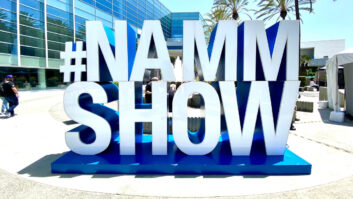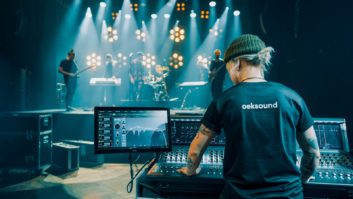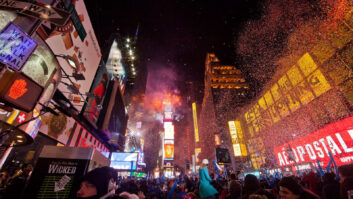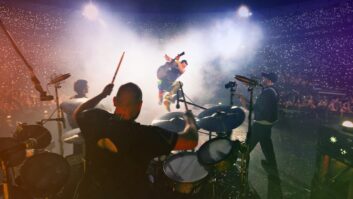
Recording live ensemble performances is my drug of choice, and I emphasize it in all of my classes. I typically invite former and current students to participate and/or observe, and they have reciprocated by bringing me into the loop to plan, consult and be on hand for the good times and the free adrenaline rush!
advertisement
The sessions are held at two locations: the Minneapolis Media Institute (MMI, mediainstitute.edu) and the Institute for Production and Recording (IPR, ipr.edu). MMI is the former Flyte Tyme studio complex (home to Jimmy Jam and Terry Lewis for about 20 years), located in Edina, a suburb of Minneapolis; the latter is in Downtown Minneapolis. The session detailed below took place a few months back at MMI.
ORGANIZATION
Technology has made it easier for one person to wear all the hats, which is fine for track-at-a-time and overdubs. But sometimes it’s worth reminding students that they don’t have to give a solo performance. I encourage them to assemble a team, to assign roles and to plan in advance—music pre-production and tech days—to reduce the day-of-session stress and surprises. Someone has to be in charge of listening to the performance, another to listen for and get good sounds, and another to make sure it is being recorded as mapped out. It also helps to have a dedicated studio assistant.
PREPARATION
What was interesting this time around—in hindsight, albeit—was how much cross-pollination happened among four seemingly random sessions. The test session was singer-songwriter Matt Guerin, an IPR student whose band came to play for my MMI class (at 8 a.m.!). This not only allowed us to test the recently repaired Otari MTR-90-mkII, but at the last minute, one of the students, Shayne Hawkinson, volunteered to play bass. Shayne would be the Pro Tools operator on the upcoming rockabilly session and would later invite me to engineer a tracking session for Ella Reid, for which he was both producer and bassist.
The big four-day event was Ross Kleiner and the Thrill. Ross and his producer/engineer, John Rausch, were in my Studio Maintenance/Basic Electronics class at IPR several years ago. My analog class recorded Ross playing “Summertime Blues” to 4-track, with John on drums. Four years ago I connected John with Dan Wilson, a client who was looking for an in-house engineer. They hit it off very well and have been working together ever since. The experience has been great for John, who generously shared some tricks, techniques and attention to detail with Shayne and Joe Speranzella. Both John and the band graciously accommodated the many visitors, students, instructors and friends who dropped by to observe.
The goal was to use as much vintage equipment as we could find and record to analog tape, using no click, no headphones and mostly ribbon mics. John produced, the two of us shared engineering and technical chores, Shayne was the PT operator and Joe ran the multitrack. (We recorded simultaneously to analog tape with PT as backup.)
TECH TIME
During the years John spent in my shop, we worked on several microphones and assorted bits of recording gear. John has continued to experiment with condenser and ribbon mics, including fabricating ribbons for the mics he repairs, including a Turner Model 87 ribbon (see Fig. 1). The tuning for this mic yielded a unique sound that just happened to perfectly complement the stand-up bass.

Fig. 1: The Turner Model 87 ribbon microphone. The inset shows the ribbon John Rausch corrugated and installed.
ANALOG TAPE OPTIONS
For the past eight years, I have been recording at 15 ips, using IEC EQ, 3 dB to 6 dB above 250 nWb/m (depending on tape). The Studer A-827 VU meters include three peak LEDs that are very helpful for recording percussion—VU meters are too slow to be accurate. The Otari MTR-90 mkII has no peak LEDs, so it was necessary to listen to playback while recording to avoid pushing too hard. Because the tape machine (in input) was feeding Pro Tools, we took advantage of the 192’s meters as well as the “virtual meters” to keep an eye on the peaks.
WHAT, NO HEADPHONES?
We worked very hard to get a vocal-friendly instrument balance in MMI Studio A so that Ross could hear everyone without straining his voice. Drums and bass were in the room, and the guitar amps were placed in the booth with the doors open. We used a myMix cue system in a very unconventional way by feeding the power amp of my modified Fender Pro Junior to drive its own speaker as well as the woofer of a Yamaha NS-10 (sans crossover). It was basically a monster set of headphones that allowed Ross to move around and feel the band in the room (Fig. 2). Not having tweeters reduced the chances of feedback in that frequency range.

Fig. 2: Ross Kleiner at the RCA 77DX. The SM-58 is a prop and the modified Fender Pro Junior is one-half of his cue mix system.
Photo by Steve Yeager
BEGGED, BORROWED and RENTED
I had posted the session dates on Facebook as Invite Only. My friend Chuck Anderson immediately volunteered his vacuum tube gear. We used his Echoplex into a Fender spring reverb to feed two Tweed Era guitar amps, a Gibson and a Tweed Deluxe (courtesy of Kevin Bowe), on which we respectively placed a Reslo ribbon (dirty amp) and the RCA 44A (clean amp). To hedge his bets, John rented an RCA 77DX and a pair of Dynaudio BM-15A monitors from themiclocker.net. From IPR we borrowed a pair of Coles 4038 ribbon mics, one of which was used as the drum overhead, my EV 664A on kick and Chuck’s Sony C-37A condenser on snare. Nate Reitsma is a friend-of-a-friend who loaned us a pair of Royer R-121 ribbons (room) and an Avalon 737 that I had repaired.
MMI recently upgraded its control room to include preamps by API (kick and snare), Avalon, DWFearn (Royer), Great River (guitars), Millennia and Shadow Hills. My rack was also in the mix, and it included an Altec 438 (bass amp) and 1612 (OH), Neve 1272 with JLM mod (OH), UREI LA-3 and a Great River transformerless preamp.
Ross had his heart set on re-creating the raw sounds of 1950s rockabilly, where the vocal mic and/or preamp are just at the edge of distortion. My modified Pultec MB-1 did exactly as I had hoped. I brought several tube options, one in particular for the output amp, to reduce headroom just enough to elevate even-order harmonics. I also added a simple optical limiter circuit to keep the signal within the sweet distortion zone.
Images and sound samples can be found at: http://www.tangible-technology.com/music/ross/rock-a-dex.html
BALANCE
Both Ross and Ella got an album’s worth of tracks to work with, and I felt very lucky to have been able to contribute to the process. To share my skills and interests with students, especially the ones who see the value in the technical aspects, is very rewarding. For John, it was especially validating to see how he had integrated new experiences on top of the foundation. He brought the same sense of adventure, of constantly trying new things, of not being afraid of leakage and being open to “happy accidents.” True, experimentation is easier to do in a classroom where you don’t have the pressure of hourly billing, but these sessions were just as intense as the real deal, with paid musicians and a narrow window to get the job done. I always end up real proud of the students.







